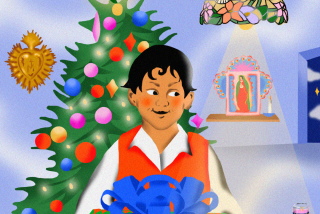Dutch Santa, Authentic Sinterklaas, Faces Challenge From Anglo-Saxon Interloper
- Share via
AMSTERDAM — As Santa Claus gets ready to do his rounds this Christmas, the Dutch have long since celebrated his annual visit to their country.
For in the Netherlands he brings his gifts on Dec. 5 to mark the feast of St. Nicholas, a tradition which Dutch settlers took to America.
But the Anglo-Saxon version of Santa has been gaining popularity here and some fear that he could even oust Sinterklaas, as he is known in this country.
To many Dutch people, the Anglo-American Santa is a pale imitation of the authentic Sinterklaas. They see him as an impostor undermining cherished local customs and traditions.
“Nothing else is quite as nice as the Sinterklaas festival, but we could lose it if we’re not careful,” says Amsterdam writer Nicolaas Matsier.
Matsier and his family celebrate Sinterklaas the traditional way, but he fears that they belong to a dwindling minority.
“Sinterklaas is all about jokes, surprises and funny poems, but some people are too lazy to make the effort these days.”
Although they share common origins and a preference for red robes and white beards, the two Santas have distinct identities.
The Anglo-Saxon Santa is a secular figure but Sinterklaas is a Catholic bishop complete with mitre and staff.
Santa Claus lives at the North Pole while Sinterklaas resides in Spain, somewhat closer to the home of the historical St. Nicholas who was Bishop of Myra in Turkey.
Santa delivers his presents for Christmas Day in a sleigh drawn by a team of reindeer, but Sinterklaas always arrives by steamboat and travels around the Netherlands on a white horse.
Dutch schoolchildren rehearse special songs in the weeks before Sinterklaas arrives and the excitement gradually builds up until Dec. 5.
Youngsters await his arrival with a mixture of eagerness and dread, for Sinterklaas keeps a big book in which he records all of their good and bad deeds.
Good children are rewarded with presents, but naughty ones are bundled into a sack and taken off to Spain.
Since the 19th Century, Sinterklaas has been helped by a mischievous, dark-skinned servant known as Zwarte Piet (Black Peter).
Concern about racism made Zwarte Piet a controversial figure in the 1970s and 1980s, but the tradition has survived because of his great popularity across all ethnic groups.
As children grow up they join in an elaborate family celebration involving an exchange of presents and the recital of poems in which members of the family poke fun at each other.
Increasingly, however, Christmas is edging out Sinterklaas as the most important family holiday in the Netherlands.
Anton Zijderveld, professor of sociology at Rotterdam University, said this is largely due to the decline of the traditional family unit.
“The Christmas celebration fits in much better with a more individualized society,” he said.
Staunch supporters of the Dutch tradition accuse department stores and the media of promoting an excess of consumption at the expense of the innocent charms of Sinterklaas.
Some fear that Sinterklaas and Zwarte Piet are doomed to disappear unless urgent action is taken.
Matsier recommends setting up a special foundation to train teachers and parents in Sinterklaas customs and appointing a professor of Sinterklaas studies at one of the universities.
But Zijderveld is confident that Sinterklaas will survive the battle of the Santas.
“I don’t think that Anglo-Saxon fatty will gain a firm footing in the Netherlands,” he said.
More to Read
Sign up for Essential California
The most important California stories and recommendations in your inbox every morning.
You may occasionally receive promotional content from the Los Angeles Times.













